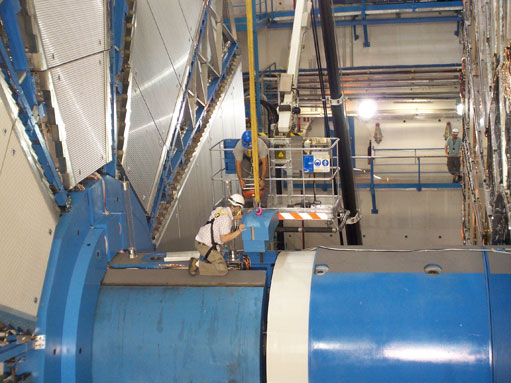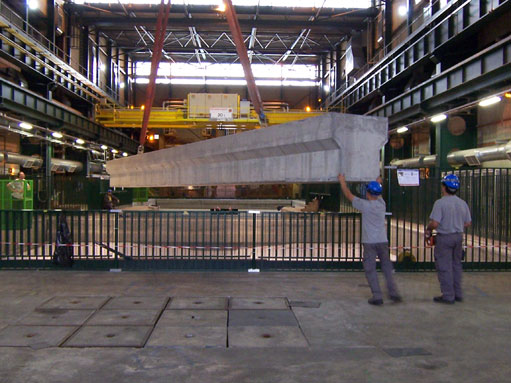
ATLAS e-News
23 February 2011
And to cap it all...
28 July 2008

Setting the last piece of shielding in place
As the Olympic Games begin in Beijing in just a matter of days, closer to home ATLAS is also getting ready to take to the starting blocks. After five long years of assembly work in the cavern, the detector is now complete, the shielding in place, and the cavern sealed.
“Closing the access shafts is something that we have expected for so long, it’s almost unbelievable,” smiled ATLAS Experimental Area Manager Francois Butin last week, no doubt reflecting the feelings of a fair few Collaborators.
The final closing of the detector itself involved a complicated dance of parts, people, and processes. The very last piece of the detector – a tiny piece of the massive forward shielding – was put in place at 2.00 p.m. on Monday July 21st. By tiny, we’re talking one tonne’s worth of metal, but Francois insists that this is nothing compared with the weight of the rest of the shielding structure. “The last-but-one bit was 94 tonnes, and the whole forward shielding weighs over 450 tonnes,” he said.
Francois has been responsible for monitoring the segment of shielding that connects with the cavern walls – the one which supports the weight of all the other segments of shielding. “On this piece, we’re putting about 300 tonnes,” he explained, “so I was checking all the time that the shielding was behaving as planned; checking the displacement and sag under the load – only a couple of millimetres, fortunately, and within the error bars of the predicted sag values.”
“It was exciting and also sometimes a bit… well, not worrying, but you can see hundreds of tonnes being stacked on that one piece,” he considered. “Even with all weights being calculated for, it’s never an exact science, is it?”
The final, comparatively small, block on side A was initially left out to allow “visual contact” with the beam pipe during preliminary tests, at the point where the bake-out equipment for the vacuum line was located. But when tests began, instabilities were caused by the excess of air circulating around the system, so the piece was fitted ahead of time.
As local tests of the bake-out equipment got underway in the pit, over 1000 tonnes of concrete in the form of huge bands – each a metre in width and height, and fifteen metres long – were being deposited at the top of the access shafts to seal the cavern off from the surface. Weighing 30 tonnes each, the 35 bands were cast on-site back in 2001, and have been stacked and waiting ever since.
Fulfilling a dual role, the caps shield radiation coming out of the cavern when the accelerator is turned on and ensure that the cavern environment stays isolated with respect to the outside, so that temperature, dew point and so on can be monitored. “We have also some air-tightness to achieve with this plug at the top,” Francois explained, “because in terms of atmospheric pressure, the cavern must always be in depression.” To achieve this, foam insulation was placed around the concrete beams, and will prevent irradiated air from UX getting into service areas during the running phase.
Beginning on Friday July 11th, the concrete strips were lifted one-by-one, cleaned, transported and lowered into place. But, explained Francois, “the problem is that when we put these beams together, there is always the risk that they’ll hit a bit and that chips of concrete will come off and hit the detector that is just 90 metres below.”

A concrete beam hangs over the shaft
In the case of the large shaft, an arrangement of large metal plates recently fitted at the bottom of the shaft in order to reduce the volume of air needing to be conditioned in the cavern, neatly doubled up as a detector protector. For the smaller shaft, Francois ordered a net – just like the one used to hang the “ATLAS Experiment” display panel on the outside of USA15 – to catch any falling shards.
Now that all the concrete strips are in place, tests of the ventilation systems in the cavern are underway, the cavern has been put into restricted access mode, and final preparations are being made for the big day. Olympic athletes won’t be the only ones holding their breath for the starting gun this summer.

Ceri PerkinsATLAS e-News
|